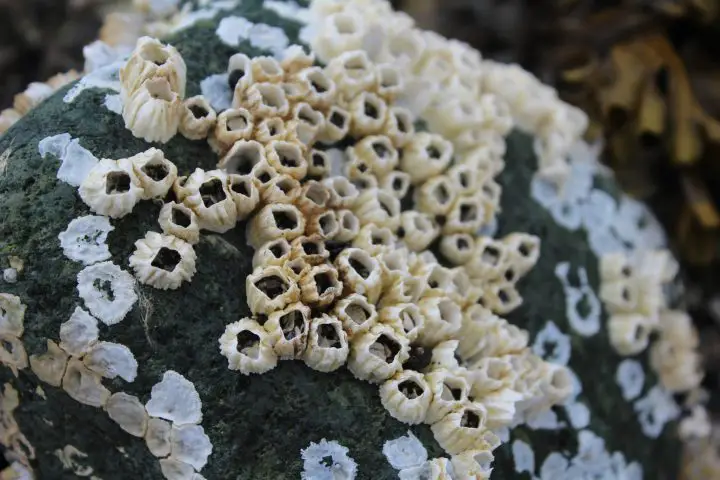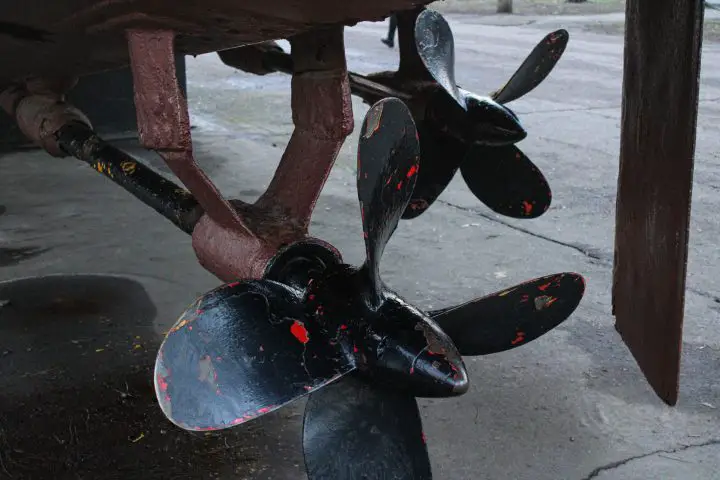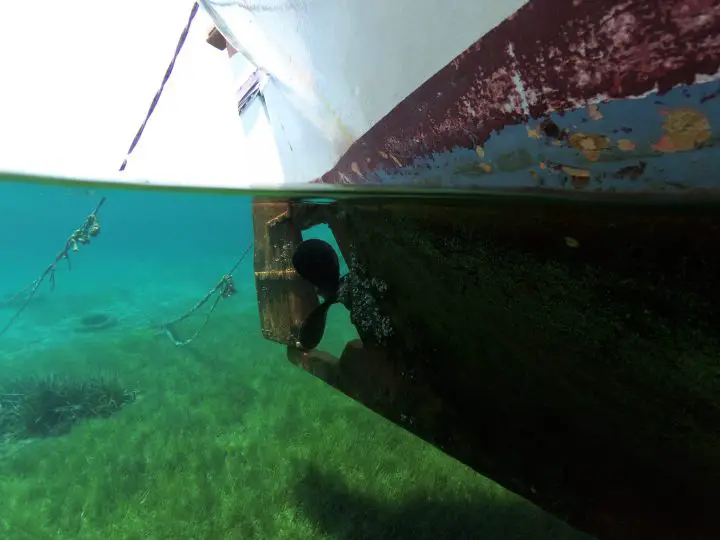Since humans began building ships and sailing the Seven Seas, barnacles on boats have been causing problems. Even today, with all our modern technologies and fancy materials, preventing and removing barnacles on boat bottoms costs the shipping industry millions of dollars annually.
What’s up with these creepy critters, anyway? Are they vindictive sea nasties, or do they have a bigger plan for ultimate global marine domination? Or is it just part of a bigger problem—one that most boaters learn sooner or later. A boat is at the mercy of the elements—and barnacles are just one more example of this simple fact.
Whatever your opinions about barnacle world domination are, let’s look a little at what barnacles do to boats and how to prevent their growth on your bottom.

Table of Contents
- Why Do Barnacles Attach to Boats?
- What Do Barnacles Do to a Boat’s Hull?
- How to Prevent Barnacles on Boat Hulls
- Got Sea Nasties? Your Not Alone
- Barnacles on Boats FAQs
Why Do Barnacles Attach to Boats?
Barnacles are shellfish that live in all of the world’s oceans. According to NOAA, there are more than 1,400 species of barnacles out there. They’re filter feeders, like oysters or clams. And like those animals, they float in water currents when they are young until they find suitable surfaces to settle on and start growing their shell.
Once they settle, barnacles start secreting a cement that is one of nature’s most powerful glues. Barnacles look for places with lots of water movement, so they’re often spotted attached to dock pilings, rocks in tidepools, the bottoms of boats, and even whales.
That powerful biological sealant is the secret to their success. It allows them to remain attached no matter how fast the water passes. In fact, it’s so powerful that scientific studies have been trying to reproduce barnacle glue for industrial purposes.
What Do Barnacles Do to a Boat’s Hull?
So, what do barnacles do once they’re attached? Basically, they just keep growing. Eventually, the entire boat bottom will be covered in barnacles. Not only do they like the boat’s bottom, but they like to grow on propellers, rudders, and even inside water intakes.
If the bottom is coated with a protective epoxy barrier coat, the barnacles attaching to the boat won’t permanently damage it. But the colony of critters can get so thick that it adds a significant amount of weight to the boat. Plus, water will no longer flow smoothly over the boat’s bottom, so drag is significantly increased.
When there is a lot of growth on the bottom, it is said to be fouled. A fouled bottom reduces speed and increases fuel consumption. In extreme cases, the boat might take so much extra effort to push through the water that you run the risk of overheating the engine!
Barnacles on the propeller can also cause major problems. The imbalance of weight on a prop can also cause annoying vibrations. Propellers lose efficiency quickly when any change is made to their shape. So a barnacle or two growing means the prop will not work as well as it should. The rudder or the bow thruster experiences the same loss of efficiency.
Finally, seawater intakes are likely to get clogged by too much growth. Too much growth will cause problems with boat systems that need outside water, like the engine cooling system or the air conditioning.

How to Prevent Barnacles on Boat Hulls
Keeping barnacles off of boat bottoms has been a problem as long as there have been boats and ships. Wooden boats had even more significant problems because worms and barnacles could get a much better foothold. They could actually dissolve the wood completely.
In those days, it was discovered that sheets of copper could be attached to the bottom of boats to reduce growth. Copper is a biocide – that is, it’s poisonous to small marine creatures. Some things might come along and grow on the bottom, but a barnacle isn’t going to decide to make a home there.
Copper Bottom Paint
Today’s modern equivalent is copper-laden bottom paint. There have been other chemicals and metals added to paints over the years, including tin (TBT). But these are incredibly harmful to the environment, so they have gradually been replaced by copper paints.
Since copper is the active ingredient, the most effective paints have the highest copper content. And while copper is less toxic than alternatives, it has been banned in several places around the world.
Bottom paints come in two basic types—ablative and hard. Ablative paints are designed to come off of the bottom gradually. So, it is very easy to clean off when the inevitable amount of growth does happen. Sometimes, just moving the boat will be enough to get it off, but usually, a scrapper and a scouring pad will do the work quickly. However, this means that the paint must be reapplied every year or so to ensure enough paint is left to prevent growth.
Hard paints do not come off. When growth occurs on these paints, it takes more work to get it off. But at the same time, the paint lasts longer and needs to be applied less often. Most users get three years or so out of hard copper paints. Even though the paint stays on, the copper additive fades away with time.
New Technologies to Remove Barnacles
Despite its widespread use and minimal impact, dispersing copper in the water is still not ideal for the environment. It also creates a lot of hazardous waste around boatyards, where boats are sanded and painted all the time. As a result, a few companies are developing novel ways and creative new alternatives to the annual drudgery of bottom painting a boat.
One solution is Coppercoat epoxy antifoul. It is similar to a hard copper bottom paint, but it is not paint. Instead, solid copper particles are suspended in an epoxy applied to the bottom of the boat. The epoxy is then sanded away, revealing a thin layer of pure copper attached to the boat’s bottom.
Coppercoat is perfectly smooth and is advertised to last ten years or more, but it still needs occasional cleaning and scrubbing. Besides the extreme lifespan, the benefit is that it is very smooth and does not leech copper into the water.
Other companies are making products using modern polymers that are super slick. Even barnacle glue cannot stick very well if it’s slick enough. While the barnacles might still attach to the boat, the idea is that they should fall off once the boat is moving. Famous YouTube sailors SV Delos experimented with a silicone-based product called SeaSpeed VX 10.
Finally, a few companies are making ultrasonic antifouling systems. These systems run an electric emitter and one or more thru-hull transducers. While these systems don’t work on soft growth, they prevent barnacles.
The advantage of both of these systems is that they do not leech any chemicals into the water, and ideally, they work for a more or less indefinite period of time.
Use a Hull Cover
This one was new on me, but looks pretty out there!
There is No Miracle Cure
Unfortunately, there is no magic bullet for preventing barnacles. Even the most toxic copper paints will not prevent all growth all the time. Underwater critters are tenacious, and they will attach to anything and start growing. So while one bottom paint might solve many of your problems in one place, move the boat to another, and you will find new critters that will start attaching themselves.
The big problem is that so many different types of marine organisms do what barnacles do. They attach to something solid, and then they start growing. Even in brackish or freshwater, there are many different types of clams, worms, slime, algae, and, well, critters! No paint can keep them all at bay.
Finally, paints really only work well when the boat moves—a lot. Most boats don’t. Even world cruisers tend to move the boat for a few weeks and then sit for a few weeks. That type of stop-and-go movement gives barnacles and other critters enough time to attach.
It’s an essential part of any paint’s job to make cleaning easy. Most owners hire divers to clean their bottoms every month or so. The growth that does form gets knocked off, and the paint is re-exposed. If you like swimming or diving, cleaning your own bottom isn’t hard and can become a fun monthly chore. It beats the heck out of the typical home owner’s yard work.
The alternative to underwater cleaning is to have the boat hauled out of the water for a good pressure washing. The first step all boat yards take after the boat is out is to scrape and clean the bottom. This is usually enough to get the growth off, and it might be the easiest way if your boat is severely fouled.

Got Sea Nasties? Your Not Alone
It has been said that the ocean is the last great unexplored frontier. Every year, scientists discover new species of critters living in the depths. As an experienced boat owner, I can tell you that the bottom of your boat is a fantastic zoological experiment that will make you feel like one of those oceanographers. If you do your own bottom cleaning, you’ll encounter all worlds of sea nasties trying to make a home down there, from barnacles on a boat to gross slime, creepy worms, and even crazy alien shrimps.
Barnacles on Boats FAQs
What causes barnacles to grow on boats?
Barnacles occur in oceans all over the world and naturally attach to any sort of underwater structure. They’re common on dock pilings, rocks, whales, and boats. They secrete a strong cement that keeps them attached to their surface of choice. The cement is strong enough to survive high-speed boating, so once they are established, there is little choice but to scrape them off with a tool. Special bottom paints are designed to help prevent barnacles and marine growth and make it easier to clean once growth occurs.
What happens if you leave barnacles on a boat?
If your bottom is appropriately protected with a barrier coat, barnacles shouldn’t cause any permeant problems to your boat bottom if you’re sitting still. But the more they build up, the more difficult and time-consuming cleaning them off will become.
You shouldn’t try to go out with a fouled bottom for a few reasons. First, the barnacles and growth will cause drag, reducing your speed and increasing your fuel burn. Growth on your propeller and rudder can affect performance—in some cases, a badly fouled propeller might not even work well enough to get you out of your slip. Additionally, barnacles can foul water intakes, making it likely that your engine will overheat from the extra work pushing the boat and the restricted water flow to its cooling system.
